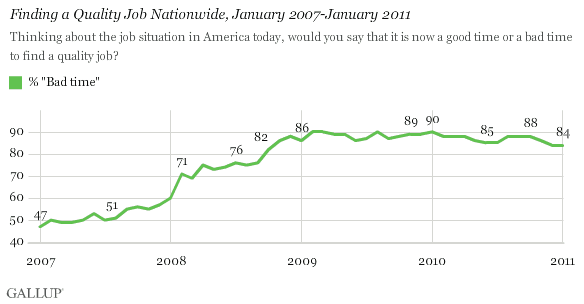PRINCETON, NJ -- Eighty-four percent of Americans in January say now is a "bad time" to find a quality job, down slightly from 90% in January 2010, but continuing a trend of high negativity that has persisted for more than two years.

While still very high, the percentage of Americans saying now is a "bad time" to find a quality job ties the December 2010 reading as the most positive over the last year -- and is the best since October 2008.
Bottom Line
Gallup this week released its new worldwide measures of employment, focusing specifically on the percentage who are employed full time for an employer, which is 40% worldwide. Gallup found that this measure is clearly related to GDP, highlighting the importance of creating quality jobs in driving economic growth around the world.
Of course, while having a job with an employer for pay is a reasonable objective in many parts of the world, that is not the case in the U.S. Most Americans want a job that uses their talents, education, skills, and experience -- a "quality" job.
In order for the United States to not only remain competitive in the global economy, but alleviate unemployment and maintain a vibrant middle class at home, it needs to create millions of "quality" jobs that currently do not exist. While Gallup's Job Creation Index as well as its Underemployment measure suggest that the jobs situation in the U.S. has been improving somewhat, at least compared with a year ago, there is still a long way to go.
Three in 10 Americans worry that they may lose their job, 18.6% are underemployed, and, as just reviewed, 84% say now is a bad time to find a quality job. So it's not surprising that 29% of Americans think unemployment/jobs are the most important problem facing the nation today.
Survey Methods
Results are based on telephone interviews with 1,018 national adults, aged 18 and older, conducted Jan. 7-9, 2011. For results based on the total sample of national adults, one can say with 95% confidence that the maximum margin of error is ±4 percentage points.
Interviews are conducted with respondents on land-line telephones (for respondents with a land-line telephone) and cellular phones (for respondents who are cell-phone only).
Interviews are conducted with respondents on landline telephones (for respondents with a landline telephone) and cellular phones (for respondents who are cell phone-only). Each sample includes a minimum quota of 150 cell phone-only respondents and 850 landline respondents, with additional minimum quotas among landline respondents for gender within region. Landline respondents are chosen at random within each household on the basis of which member had the most recent birthday.
Samples are weighted by gender, age, race, education, region, and phone lines. Demographic weighting targets are based on the March 2010 Current Population Survey figures for the aged 18 and older non-institutionalized population living in continental U.S. telephone households. All reported margins of sampling error include the computed design effects for weighting and sample design.
In addition to sampling error, question wording and practical difficulties in conducting surveys can introduce error or bias into the findings of public opinion polls.
View methodology, full question results, and trend data.
For more details on Gallup's polling methodology, visit www.gallup.com.
